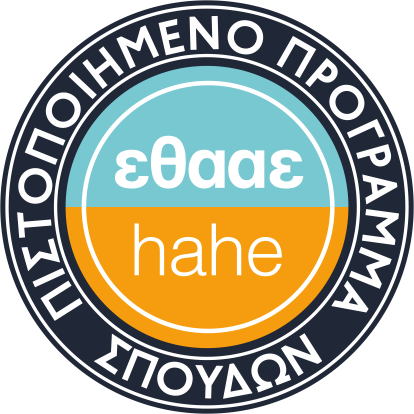AGENDA nZECom Conference
Ημερίδα AGENDA nZECom Conference 18.11.22 https://ece.uowm.gr/uploads/announcements/pdm_nzecom_programma_w.jpg

Ημερίδα AGENDA nZECom Conference 18.11.22 https://ece.uowm.gr/uploads/announcements/pdm_nzecom_programma_w.jpg
Study Guide 2022-2023 Files: odhgos_spoydon_thmmy_2022_2023_english.pdf odhgos_spoydon_thmmy_2022_2023.pdf
The PhD dissertation of Dimosthenis Tsouros received an honorary mention by the Association for Constraint Programming (ACP) as one of the best dissertations in the area of Constraint Programming in the past two years.
The PhD dissertation of Dimosthenis Tsouros received an honorary mention by the Association for Constraint Programming (ACP) as one of the best dissertations in the area of Constraint Programming in the past two years.

The present project aims to design and develop an innovative wearable device for theprevention, diagnosis and treatment of diabetes mellitus which will make use of novicegraphene structures. The implementation of this task will rely on three individual actions andmore specifically:A) The development of a very sensitive glucose bio-sensor based on graphene. Graphenelayers will be deposited layer-by-layer on a substrate (patch) with a cutting-edgetechnology Langmuir Blogget based on which chemical compounds which cansense/trace glucose will be immobilized to each graphene layer. This substrate will be asticker patch which will constantly count the glucose levels from sweat and consequentlywill be a non-invasive diagnostic method.B) The development of a release system for hypoglycemic treatment. Specific SGLT-2inhibitors and GLP-1 analogues, that are commonly used for the treatment of T2DM, willbe encapsulated into a nanoemulsion. The nanoemulsion that poses lipophilic propertieswill be then incorporated into a gelatine patch.C) Development of α device/software which, through a Bluetooth technology, will receiveelectrical signs from the bio-sensor, will analyze changes on the glucose levels fromsweat and trigger the release of the nanoemulsion from the patch via thermal heating.The final product (Actions A, B and C) will be a product of a smart expertise in the areaof biomedicine and pharmacy which deploy the tremendous development ofbiotechnology, computer science and material engineering in the last decade. Theimplementation of this project is expected to contribute not only scientifically andeconomically to the participating departments as well as the company and the country,but mainly will contribute to the management of diabetes mellitus and the improvementof the quality of life of the diabetic patientsThe suggested effort of research is fully in line with the Research and Innovation Strategy forSmart Specialization (RIS3) which aims to the development of new products for the prevention,diagnosis and treatment of diseases. Website: https://demigod.ece.uowm.gr/en/
Title: «Distributed neural network training via independent subnets»Wednesday, 2 March 2022, 12:00 – 13:30Auditorium, Department of Electrical and Computer Engineering, Karamanli & Lygeris Str Abstract: Distributed machine learning (ML) can bring more computational resources to bear than single-machine learning, thus enabling reductions in training time. Distributed learning partitions models and data over many machines, allowing model and dataset sizes beyond the available compute power and memory of a single machine. In practice though, distributed ML is challenging when distribution is mandatory, rather than chosen by the practitioner. In such scenarios, data could unavoidably be separated among workers due to limited memory capacity per worker or even because of data privacy issues. There, existing distributed methods will utterly fail due to dominant transfer costs across workers, or do not even apply. We propose a new approach to distributed fully connected neural network learning, called independent subnet training (IST), to handle these cases. In IST, the original network is decomposed into a set of narrow subnetworks with the same depth. These subnetworks are then trained locally before parameters are exchanged to produce new subnets and the training cycle repeats. Such a naturally “model parallel” approach limits memory usage by storing only a portion of network parameters on each device. Additionally, no requirements exist for sharing data between workers (i.e., subnet training is local and independent) and communication volume and frequency are reduced by decomposing the original network into independent subnets. These properties of IST can cope with issues due to distributed data, slow interconnects, or limited device memory, making IST a suitable approach for cases of mandatory distribution. This talk will provide results on MLPs, ResNets, CNNs, efficient pretraining tasks, GCNs as well as some theoretical guarantees. Biography: Mr Anastasios Kyrillidis is an Assistant Professor at the Computer Science department at Rice University. Prior to that, he was a Goldstine PostDoctoral Fellow at IBM T. J. Watson Research Center (NY), and a Simons Foundation PostDoc member at the University of Texas at Austin. He finished his PhD at the CS Department of EPFL (Switzerland). Anastasios Kyrillidis got his M.Sc. and Diploma from Electronic and Computer Engineering Dept. at Technical University of Crete (Chania). His research interests include (but not limited to): Files: invited_speaker___anastasios_kyrillidis.pdf